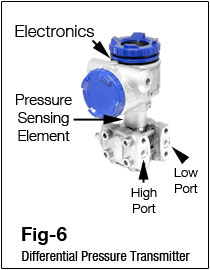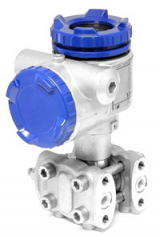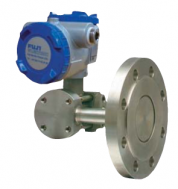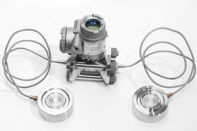Beginner's guide to Differential Pressure Transmitters
This article is a straightforward and informal guide with illustrations aimed at helping beginners to understand Differential Pressure Transmitters principles. We can offer transmitters with Exd, Exia, HART, NACE, UKAS and or SIL Certification
1. What is pressure?
Pressure is experienced when a force is applied on an area. This means that we can increase the pressure by either increasing the force or by reducing the area. We also tend to think of force in terms of weight (this is only true, if gravity is constant). As an example, the force produced by 1lb of weight due to gravity acting on 1 inch x 1 inch (1sq inch) would produce a pressure of 1lb/sq inch, this is often written as 1 Psi (1 pound per square inch). If the same 1lb was applying a force to only half the area, we would actually say the pressure was equal to 2 Psi. In our day to day experience we may pump our car tyres to 26 Psi.
We also experience pressure in the form of weather (or atmospheric pressure). This could be considered the force being appleid by the atmosphere on our heads. As the atmospheric pressure changes, so does the weather. High pressure usually referes to clear sunny days, while low pressure produces cloudy ones.
If we refer back to our car tyres, two pressures are acting on the wall of the tyre. The pressure of the atmoshere on the outside of the tyre and the pressure we read on the gauge when we pumped the tyre up.
2. What are the different types of pressure measurement?
Using the above example, we can illustrate 3 types of pressure measurement.
a) Gauge Pressure - (the pressure in the tyre) or (difference between absolute pressure and atmosheric pressure)
b) Absolute Pressure - (the combined atmosperic and tyre pressure)
c) Differential Pressure - (the difference between any two measured pressures)
But they are all related to each other
a) Gauge Pressure is measured with reference to atmospheric pressure (please see Fg.3).
Pressure measurement that measures the difference between atmospheric pressure and the tyre is called Gauge Pressure. To avoid confusion we normally add "g" to the units of measurement eg. Pound per Square Inch Gauge (Psig).
All pressure gauges, sensors, transducers and transmitters that measure gauge pressure actually measure the difference between atmospheric pressure and the pressure to be measured as shown in fig3.
If you would like to know more about this subject why not contact one of our technical team.
|
Tip |
You can see our range of Gauge Pressure Transmitters here. |
|---|
b) Absolute Pressure is measured with reference to Vacuum.
In some applications the variation in atmospheric pressure may be important. In this instance we can measure the differnce between a vacuum and the tyre. This is called an absolute pressure measurement and has the effect of adding the atmospheric pressure to the tyre pressure. as shown in fig2
So an absolute pressure is equal to gauge pressure and atmospheric pressure.
If you would like to know more about this subject why not contact one of our technical team.
|
Tip |
You can see our range of Absolute Pressure Transmitters here. |
|---|
c) Differential Pressure is not measured with reference to a specific reference pressure (see Fg.4).
Unlike Gauge or Absolute pressure transmitters, Differential Pressure Transmitters do not attempt to fix the reference. Importantly an increase in differential can be the result of increasing one of the pressures or decreasing the other.
An increase in differential pressure would occur if P1 became smaller OR if P2 became larger. In a similar way, a decrease in differential pressure would occur if P1 became larger OR if P2 became smaller. The differential pressure measurement is not concerned whether the lower of the two pressures is at a vacuum, atmospheric or some other pressure. It is only interested in the difference between the two. Asshown in Fig4
The fundamental of differential pressure measurement is established.
Not all Differntial Pressure transmitters, gauges, sensors, and transducers that measure differential pressure actually measure the difference between two pressure as shown in fig4. Some devices attempt to measure two gauge pressures and then mathematically calculate the difference. This method in our opinion is flawed, as it contains the uncertainty of four pressure measurements. If you would like to know more about this subject why not contact one of our technical team.
3. Where is Differential Pressure (DP) Measurement used?
Differential pressure measurement is largely used in domestic and industrial applications. It is often the basis of other measurements such as flow, level, density, viscosity and even temperature. The most common being level and flow.
DP Flow rate measurement (Fig-5) is one of the most common applications for differential pressure transmitters. By measuring the difference in fluid pressure while the fluid flows through a pipe it is possible to calculate the flow rate.
Differential pressure flow meters have a primary and a secondary element. Generally speaking , the primary element is designed to produce a difference in pressure as the flow increases. There are many different types of primary element, the most common being the orifice plate, venturi, flow nozzle and pitot tube.
The secondary element of the flow meter is the differential pressure transmitter. It is designed to measure the differential pressure produced by the primary element as accurately as possible. In particular it is important that the differential pressure measurement is not affected by changes in the fluid pressure, temperature or other properties such as ambient temperature.
A good dp transmitter will ensure that the differential pressure is measured accurately independent of other changing parameters and will reliably transmit a signal to represent the differential pressure. In the case of a dp flow transmitter the output signal may also include square root extraction. Although it is common these days for this function to be carried our in a flow computer of Dcs system.
The output signal from and industrial DP transmitter is likely to be 4-20mA, but it may also include digital communications such as HART, Profibusm Fieldbus, Modbus 485 RTU or one of many other communication protocols. The objective being to provide an electrical signal for transmission to a remote process control instrument. See Fig-5.
Now we have discovered what differential pressue is and how it is used we can now focus our attention on the Differential Pressure Transmitter itself
4. What is a Differential Pressure Transmitter?
The most common and useful industrial pressure measuring instrument is the differential pressure transmitter. This equipment will sense the difference in pressure between two ports and produce an output signal with reference to a calibrated pressure range.

The industrial differential pressure transmitters are made of two housings (See Fig-6). Pressure sensing element is housed in the bottom half, and the electronics are housed at the top half. It will have two pressure ports marked as “High” and “Low”. It is not compulsory that the high port will be always at high pressure and the low port always at low pressure. This labeling has its relation to the effect of the port on the output signal. This point is clarified in Fig -7 (Please see Fig 7).
|
Tip |
You can see our range of Differential Pressure Transmitters here. |
|---|
At this stage, we will try to explain the internal construction of the transmitter.
5. Differential pressure transmitter construction:
A differential pressure transmitter has three functional parts.
1) Direct Pressure sensing element (located in the lower housing).
The majority of industrial DP Transmitters are fitted with diaphragm as the pressure sensing element. This diaphragm is a mechanical device. It is placed in between the two pressure inlet ports. The diaphragm will be deflected by the applied pressure.
This is clarified in Fig-7. This deflection is converted into an electrical signal. This is normally done by the sensors. The commonly used sensors are (a) Strain Gauge (b) Differential Capacitance (c) Vibrating wire. The sensor output is proportional to the applied pressure.
2) Electronic Unit: The electrical signal generated at the lower chamber by the sensor is in the range of milli-volt only.
This signal is to be amplified to 0-5V or 0-10V range or is to be converted to 4-20mA for onward transmission to a remote instrument. This upper housing is the Transmitter portion of the DP Transmitter which houses the Electronic Unit. See Fig-7 for further clarifications.
3) 2-Wire 4-20mA Current Transmitter:
A DC output current is generated which is directly proportional to the pressure range of the Differential Pressure Transmitter. The lower range is 4mA, and the upper range is 20mA. This controlled current output is not affected by load impedance variation and supply voltage fluctuations. This 4-20mA output is superimposed with digital communications of BRAIN or HART FSK protocol.
6. Industrial applications of Differential Pressure Transmitters:
There are unlimited industrial applications of Differential Pressure Transmitters.
- Oil and Gas flow metering in onshore, offshore and subsea applications.
- Water and effluent treatment plants. It is largely used to monitor filters in these plants.
- It is used to monitor Sprinkler Systems.
- Remote sensing of Heating Systems for Steam or Hot Water.
- Pressure drops across valves can be monitored.
- Pump control monitoring.
|
Did you know? |
Fuji Electric Pressure Transmitters are designed to work on tough applications that require high accuracy. You can learn more about these High Accuracy Pressure Transmitters here. |
|---|
|
Did you know? |
That if you have a large project for Differential Pressure Transmitters we can help you select the correct transmitter for the application? |
|---|
This article has covered the basic aspects of Differential Pressure Transmitters. You can also have a look at our range of Differential Pressure Transmitters or contact us if you have a specific application that you would like to discuss.
See also
Gauge |
|
High Performance Gauge Pressure Transmitter (0.04%)A full range of high accuracy, ultra stable pressure transmitters especially suitable for tough application typically found in the oil, gas or power generation industries. |
 |
General Purpose Pressure Transducer (0.25%)Reliable pressure measurement for less demanding applications. Typically delivers a 4-20mA signal. Wide range of pressure available. |
 |
OEM Pressure Transducer (0.25%)A lower cost unit ideal for OEM application |
 |
Absolute |
|
High Performance Absolute Pressure Transmitter (0.04%)A full range of high accuracy, ultra stable pressure transmitters especially suitable for tough application typically found in the oil, gas or power generation industries. |
 |
Differential |
|
High Performance Differential Pressure Transmitter (0.04%)A full range of high accuracy, ultra stable pressure transmitters especially suitable for tough application typically found in the oil, gas or power generation industries. |
 |
Pneumatic Differential Pressure TransmitterMeasures the differential pressure (dp) and supplies a 3-15 psi output without any electronics.Perfect for traditional explosion proof protection in hazardous areas. |
 |
High performance DP Transmitter
DP transmitter for levels
High static DP Transmitter



